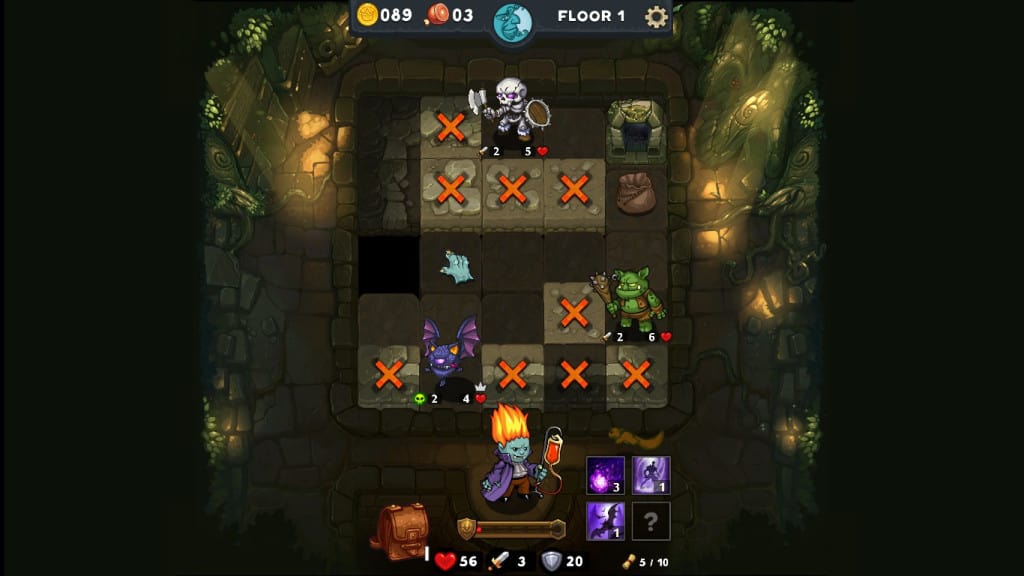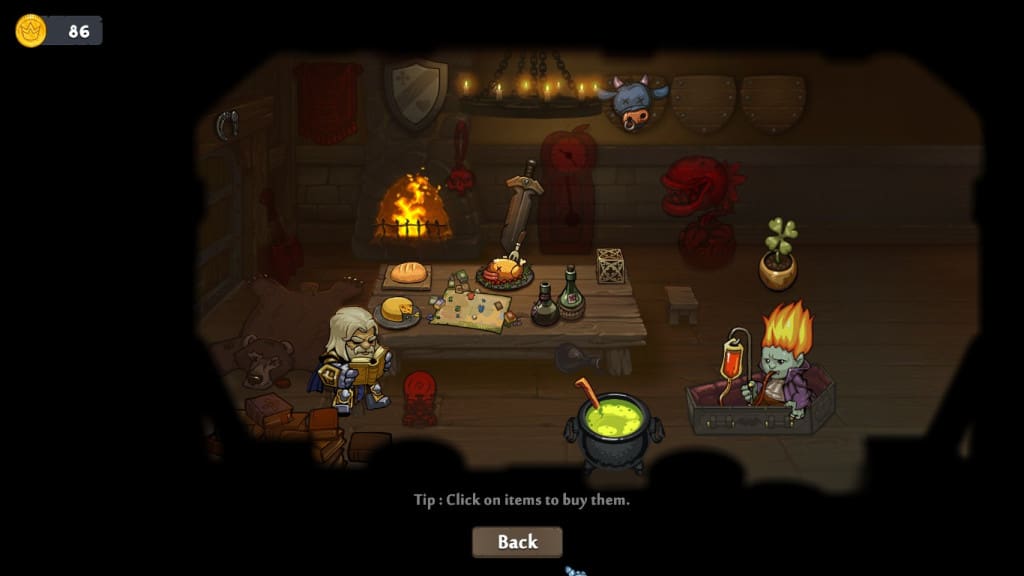Platforms PC/iOS Genre RPG
Developer Red Winter Software Publisher tinyBuild
Platform Played PC
Dungelot: Shattered Lands is the third entry in the RPG series which tasks players with fighting their way through randomly-generated dungeons. A healthy variety of enemies, mini-games, boss fights, and judgment calls are encountered along the way, making for an incredibly charming and entertaining journey.
At the game’s outset, there is only a singular character, the Paladin, you may take control of during your dungeon-crawling, but as you progress, more characters become unlocked. Each of these characters needs to be taken through dungeons separately to be leveled up, and initially this seems like a hindrance as you find yourself having to replay the same levels you have already completed, just with a different sprite. Fortunately, this sentiment quickly fades as the unique character skills and randomly generated dungeon levels showcase just how different every playthrough can be, with only a handful of elements remaining identical. Across character playthroughs, the number of floors found in each dungeon remains the same, there is a boss to defeat on the final floor, and on every fifth floor you will locate a tavern, providing you with a single chest of food or gold, a bed you may use to recover health, and a merchant who can buy or sell various items. Outside of those exceptions, each floor in the dungeon is randomly created, and may even contain mini games or friendly NPC’s rather than panels of flooring which hide enemies and items. Even if you return to a dungeon you were previously unsuccessful at completing, the floors will differ from your last attempt(s).

In order to progress to the dungeon’s next floor, you must locate a key which will unlock the stairwell. It is hidden somewhere underneath a square on the floor’s dungeon, but you must make your way by overturning a single panel at a time. There are items which will inform you of what is lying in wait underneath the panels, but the majority of any playthrough is centered around luck. If you happen to stumble across an enemy, any panel you have not yet overturned which is still making contact with the enemy’s space will become inaccessible until you defeat the creature. There may be dungeon floors which force you to fight several enemies in a row before you can even finish making your first two or three moves, but there may be other times when the key you need is two spaces away from your starting point. While this may seem like an incredibly wild degree of variance, it also means that the game is never intentionally punishing. There is a degree of difficulty, and a learning curve which requires you to discard many of the established gaming trends in order to succeed, but attempting a dungeon immediately after experiencing defeat at its hands may result in a completely different outcome, thus eliminating much of the discouragement found in dungeon crawling titles.
When I suggest that many gaming trends must be forgotten in order to succeed in Dungelot: Shattered Lands, I refer to notions such as complete exploration always being the best option or all monsters in a level must be defeated. No experience is rewarded for defeating enemies in this title, although chests may appear after defeating all enemies on a single floor or defeating one bearing a crown symbol above its health statistic. these chests contain coins or items, but considering you have very limited opportunity to heal significant portions of your health while traversing the dungeon, it is often best to simply explore until you find the key or you have gone as far as you can without having to engage in battle. Completely exploring every floor in a dungeon works with ease for the first level or two, but after that, when entering dungeons containing 20 or more floors, uncovering every panel on each floor is a recipe for certain death and failure. Likewise, defeating every enemy you encounter will result in a severely diminished health bar long before you reach the top floor and death will be lingering over your shoulder until you ultimately fail. Once you have modified the way you approach the game, things become infinitely simpler and more enjoyable.

To aid in your dungeon travels, there is a crafting mechanic, items to buff your offense or defense, a mood meter which will influence your combat, permanent buffs you can purchase from within the abode your heroes share, new weapons and armour to unlock by completing certain tasks, and a goddess you may purchase temporary upgrades from prior to entering dungeons. There is absolutely no shortage of ways to alter your heroes or improve them, and any gold you accrue during a playthrough is saved universally, across all characters. This makes it far more appealing to try the various heroes you unlock as permanent buffs and coins transfer, despite everyone having their own individual stats.
The biggest negative to be found in Dungelot: Shattered Lands is also one of its biggest positives. Forcing the player to go against so many trends which have been ingrained in a player’s head through years of gaming in order to stand the best chance of winning can be incredibly frustrating at first. Video games have always provided an alternate sense of reality, one where the protagonist is placed on a pedestal and, at least in most RPG’s, has survived numerous brushed with death by the end of the tale, even if it required numerous attempts to reach that point. To have it suggested that not only is it in your best interest to avoid conflict when possible, but that scouring every inch of a dungeon is not advisable is almost RPG heresy, yet Dungelot: Shattered Lands does just this. This negative element is only temporary, and is an issue with the player’s mindset more than the game.
Dungelot: Shattered Lands is not an incredibly deep or expansive game, but it provides a thoroughly enjoyable experience and breaks the mould to present players with a fresh style of play. There is a quirky sense of humour found throughout the title, whether it stems from defeating a zombie cow or watching as the giant finger of God descends from the top of the screen to instantly kill an enemy. The rogue-like elements found within the game help alleviate any of the grind associated with replaying dungeons as different characters but also ensure failure is never set in stone. Given the nature of the game, it’s a great title to pick up and play for five minutes or sit down and dedicate an hour to, with no two dungeon attempts being identical. Anyone who can work past the mental and behavioural barriers established through more traditional RPG games will undoubtedly have a blast playing Dungelot: Shattered Lands.
The Good
- Offers a fresh approach to dungeon crawling and RPG’s
- Rogue-like elements make every dungeon attempt unique
- Fantastic variety of enemies, items, and spells
The Bad
- Players must get past established gaming notions of extensive exploration to succeed




